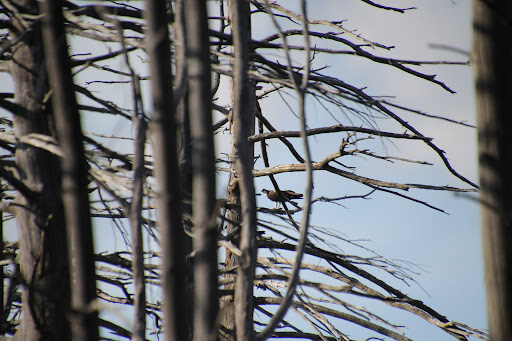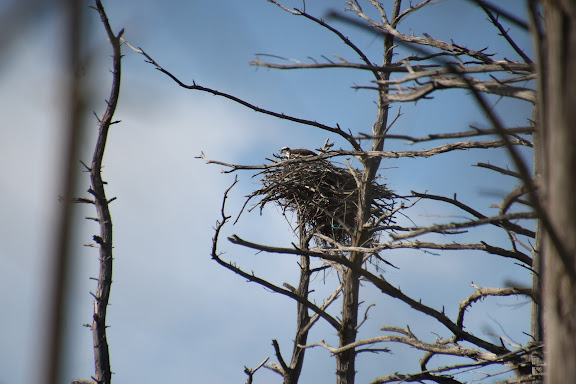The Osprey Nest, Maynard MA
Now that I have my license, I've been visiting Assabet River National Wildlife Refuge, which is in Sudbury, Stow, Maynard, and Hudson. This is a great place to find wildlife, because of it's sheer size. It is a combination of woodlands and beaver ponds, along the Assabet River.
When Europeans arrived in New England, beaver trapping became a big industry. They were trapped for their fur until they almost went extinct in the Eastern US in 1900. During beaver's 200-300 year absence, beaver ponds turned into fast flowing, narrow rivers, and the water level dropped. Pine trees temporarily grew in the newly formed land. During the last hundred years, conservation efforts have re-introduced beavers across New England. The temporary forests were re-flooded, and the pine trees died.
Now that beaver ponds have re-formed, the standing skeletons (snags) of pine trees remain, protruding from the water, which are a great place for great blue herons to build their nests. About 1 in every 4 of these dead trees has a big clump of sticks in it. Those are heron nests. I've actually started photographing heron nests fairly recently, which is why I was at the beaver pond on the 12th of April. I wandered along the side of the river in my Crocs. I saw a beaver swimming very close to me, a garter snake, and way too many ticks running up my pant legs. I made my way to a path I recognized, and walked down it. I soon saw a photographer like me pointing his camera out into the wetlands. He was watching a heron nest. On a branch nearby sat an osprey, probably just recently returned from a winter in mexico. It was about 300 feet from us. I skipped that opportunity and decided to sneak along the riverbank, and get closer. I was maybe 100 feet from the nesting tree's base, and the nest was about 40 feet above the ground. I couldn't get closer than that without wading in deep, muddy water. I could see the osprey through the branches, still in the same spot:
After a minute, The osprey's mate soared out of the woods and onto the nest. My camera was frustratingly focusing on branches that blocked my view, rather than the flying male osprey, which made me even more frustrated when I saw that the bird was carrying something. Either nesting material or a fish, I couldn't tell. It landed in the nest, and my camera FINALLY focused.
I waited for it to take off again, which only took a few minutes...
It's too early in the year for chicks or eggs, unfortunately. Osprey apparently lay their eggs in late May, and raise the chicks on regurgitated fish over the summer. As soon as the brood learns to fly, dive, and hunt, the whole family migrates down to mexico (in late fall), where the chicks will become independent from their parents.
I plan to return to the same place very soon, to do another update.
I learned that afternoon that ospreys steal the nests of great blue herons. Before, I had only seen them nest in man-made platforms, in cape cod. I am very excited to watch the same thing happening inland. They seem to leave the herons alone though, as the whole time, a heron had been sitting calmly on it's nest, nearby. There were also red winged blackbirds who surprisingly left the pair alone.
They ended up meeting up before I left. They mated for about 3 seconds and then flew off. I can expect chicks soon! stay tuned.





.jpeg)

Comments
Post a Comment